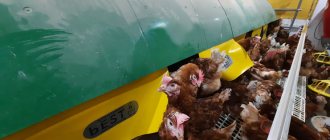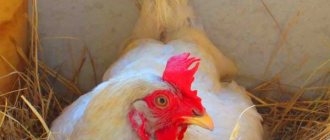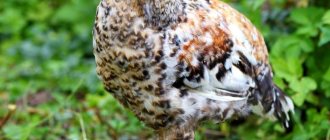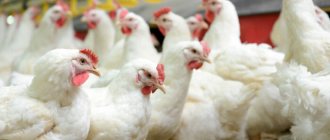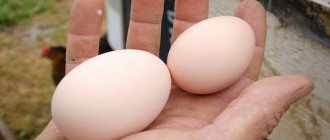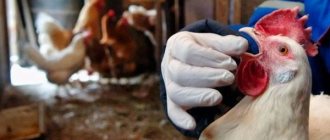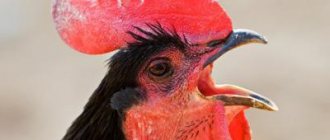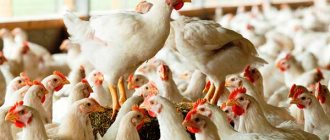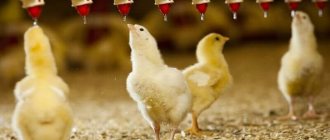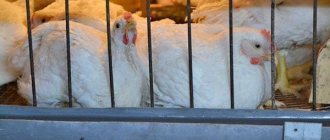Home » Articles about chickens » Daylight hours for chickens
One of the factors influencing the growth and development of chickens is the length of daylight hours. This parameter differs at different stages of development. When organizing lighting, it is important to consider the direction of productivity.
Effect of light regime for broilers on feed consumption
From the second week of rearing, birds should be given regular periods of darkness during which to rest.
Lights should be turned on and off at the same time to develop feeding habits in broilers. As a result, they will feed heavily every time before turning off the lights. Light mode for broilers
From the moment of consumption of food until it is completely digested in the gastrointestinal tract of birds, about 5 hours pass. Therefore, when using programs with long periods of darkness (more than 5-6 hours at a time), birds develop a strong feeling of hunger. In this case, every time the light is turned on, the chicks will crowd around the feeders, scratching and tearing the skin on each other's sides and backs. If E. coli bacteria enter the wounds, this will lead to the development of cellulite and the need for disposal of the carcass after slaughter.
Ultraviolet
An ultraviolet lamp for heating chickens is a conventional-looking device that converts electrical energy into ultraviolet light.
The advantages of such heaters are the destruction of pathogenic bacteria. Enrichment of chicks with vitamin D. And targeted heat transfer.
However, prolonged exposure to ultraviolet light can harm chickens. Therefore, experts recommend using UV devices only for disinfecting the chicken coop, and not for heating.
When choosing such light bulbs, special attention should be paid to their power. It is determined depending on the area of the room. That is, the smaller the chicken coop, the less powerful the ultraviolet lamp should be.
What is the optimal length of daylight for broilers?
Long periods of light give birds more time to feed. However, continuous lighting can excessively accelerate the metabolic rate and cause the development of cardiovascular disease, sudden death syndrome, and thus increase the mortality rate in the herd. In addition, continuous lighting provokes problems with the musculoskeletal system, increases the stress response and weakens the immune system.
Studies examining the effect of lighting duration on the body of broilers have shown that:
- Short daylight hours (14 hours of light or less) reduce the growth rate.
- A constant photoperiod (23 hours per day) leads to a decrease in bird welfare. As a result, physiological changes develop within the body, leading to a decrease in growth rate and food consumption, and disruption of circadian rhythms and melatonin production. In addition, continuous lighting stimulates changes in the behavior of birds, increases their apathy, reduces locomotor activity and feeding behavior
- Broilers are able to adapt their feeding behavior to compensate for the shorter day length. With intermittent light programs, the habit of consuming more feed in advance of the dark period gradually develops.
- Data on the effects of lighting on broiler production indicate that broilers exhibit the best performance when lighting durations range from 17 to 20 hours of light per day.
Effect of daylight hours on broiler productivity
Luminescent
The operation of the lamp is based on mercury vapor. It is located inside a glass flask. And it is heated on both sides by soldered heating coils.
As a result of heating mercury, a discharge of its particles occurs, accompanied by a glow.
Due to the following positive characteristics, this type of heater is often used in poultry farming:
- low energy consumption, allowing you to save a lot of money;
- relatively high light output;
- long service life exceeding 10,000 hours.
One of the disadvantages is the high flicker frequency. This is a kind of irritant for chickens, making them restless. And sometimes aggressive.
A fluorescent lamp has a low level of heat transfer. And due to the mercury content, problems arise with its disposal.
Effect of light intensity
Light intensity has a noticeable effect on bird activity. The higher the light intensity, the more active the bird is. High activity is desirable when placing and acclimatizing chickens in the poultry house. During this period, it is necessary to provide conditions under which broilers can easily find food and water. Therefore, in the initial phase of fattening, the light intensity should be greatest.
Low lighting intensity at a later age allows the bird to remain calmer, static and less active, which promotes live weight gain in the final phases of growth, reduces the level of injury and the development of fibrinous cellulite. In addition, it is very important to ensure uniform lighting intensity throughout the house and to prevent the formation of too light or dark areas. The bird avoids highly lit areas; the litter in such areas cools down and moisture condenses on it.
Heating systems for chicks in the first days of life
A variety of means are used to heat a cage or box. Small containers, where it is quite easy to maintain a comfortable temperature for chickens in the first days of life, can be warmed using:
- water or electric heating pad, protected from moisture;
- bottles with warm water wrapped in several layers of cotton wool, wool or cotton fabric;
- incandescent lamps;
- one or two reflectors fixed in a place inaccessible to the chicks.
Whatever the box is heated with, you need to remember about safety, the ability of individual heat sources to cool down or, on the contrary, to heat up excessively, and also that the air is heated unevenly most often. Near the heater the temperature for the chicks will be 3-6°C higher than in the opposite corner of the box.
Egg-laying chickens are generally more active than their broiler counterparts. Therefore, to save money in the first few days, a large house for chicks can be divided into parts. This will not only save energy, but also help kids save precious energy. Heating of the cage or box is necessary until the age of one month, then:
- the temperature in the cages for chickens is set at 18 °C;
- On deep litter, the chicks live at temperatures up to 15 °C.
Effect of lighting color
Effect of lighting color on broilers
The effect of lighting color on growth in broiler chickens is not as pronounced as in laying hens. In commercial broiler rearing, white, warm or cold light is used. Blue and green colors have a positive effect on bird growth, but they have a negative effect on litter quality and leg health.
Light programs for broilers
It is important to develop a lighting program that will balance bird activity and welfare, optimize production levels and minimize potential problems.
There is no optimal lighting program. Nevertheless, there are a number of recommendations that must be followed when organizing lighting in a poultry house:
- On the first day after being placed in the house, the chicks are given constant light. Thus, the growing cycle begins with a 24-hour photoperiod of continuous light. This stimulates the intake of feed and water by broilers and guarantees a successful start to fattening, as well as good development of the digestive system and immunity. Set the maximum light intensity: from 60 to 100 lux.
- From the 2nd to the 6th day of life, a period of darkness is gradually introduced, giving the bird a rest period (23 hours of light; 1 hour of darkness). Gradually reduce the light intensity: from 60 to 20 lux.
- From 7 days of age or when chicks have more than quadrupled their original weight, the period of darkness should be gradually increased throughout the second and third weeks of rearing. The light intensity is reduced to 5-10 lux.
- Then, starting from the 32nd day of life, the period of darkness is gradually reduced so that by the time of slaughter the daylight hours are again 23 hours.
An example of a light program for broilers is shown in the table.
| Age, days | Duration of illumination | Darkness, h | Intensity, lux |
| 1 | 24 | 0 | 60-100 |
| 2-6 | 23 | 1 | 20-60 |
| 7* | 22 | 2 | 5-10 |
| 8 | 21 | 3 | 5-10 |
| 9-31 | 20 | 4 | 5-10 |
| 32 | 21 | 3 | 10 |
| 33 | 22 | 2 | 10 |
| 34 and until slaughter | 23 | 1 | 10-20 |
*change of lighting on day 7 with an increase in broiler live weight by more than 4 times
In the period from 9 to 31 days of a broiler’s life, the same lighting scheme is used: periods of light and darkness should be in the ratio 5C:1T, 4 approaches per day (C - light, T - dark). The rest of the time, the number of light and dark periods is changed.
Other heating devices
Mat and its replacement
In many specialty stores you can see a heating mat for chickens. It works from the electrical network.
But before purchasing such a device, you should know that it has low technical characteristics. They negatively affect the service life. Among the parameters are:
- power: from 40 to 80 W;
- temperature range: from 35 to 45 degrees;
- heating time: 10 to 15 minutes;
- The mat must be supervised during operation.
In addition, under no circumstances should the operating device be filled with water or covered with any object. And if it doesn’t work, break it or pierce it.
Therefore, instead of a mat, it is better to use ordinary electric or water heating pads. They are more resistant to aggressive environments and are easy to use.
Alternative options
As an alternative, you can use plastic water bottles. Before being placed in the brooder, they are wrapped in soft cloth. A significant drawback: you will have to constantly change the contents of the bottle as it cools.
To heat young animals, it is possible to use other homemade heaters of various designs. For example, wood or coal stoves, electric convectors, oil radiators or gas appliances.
Let's sum it up
From the above we can conclude that it is better to use infrared lamps to heat chickens. Compared to other devices, they are effective, economical and safe.
Dear readers of our site, please tell us in the comments whether the recommendations from the article were useful to you. You may be using other methods to keep your chicks warm. Your advice will be useful for novice poultry farmers.
Reposting will help you track the responses to your comment. Special thanks for the 5 star rating.
Types of lamps
broiler light mode
Various types of lamps (luminaires) are used in poultry house lighting systems:
- incandescent;
- LED;
- luminescent;
- halogen
Each type of lamp has its own advantages and disadvantages.
Currently, the optimal solution for organizing poultry house lighting is the use of LED lamps. LED lighting guarantees uniform light distribution as well as the required intensity at every stage of production.
Lamp selection
To illuminate the room you can use lamps:
- incandescent - the most affordable, but uneconomical option in terms of energy consumption;
- fluorescent - they are durable, at the same lighting intensity they consume almost 5 times less electricity compared to incandescent lamps, but the flickering frequency has an irritating effect on birds;
- LED - have a long service life, provide high-quality lighting (you can choose the brightness of the glow), and are highly energy efficient.
In poultry farms, lamps are mounted in lines. In private households, lamps are installed on the ceiling, providing the maximum level of lighting above the feeders and drinkers. To maintain the on/off mode, it is convenient to use automation.
Automatic control of the light mode of broilers
The capabilities of modern control computers allow the lighting system to operate autonomously. At the set time, the computer itself will turn off or turn on the lighting lines, and also change its intensity in accordance with the specified technological settings.
As an example, the photo shows the Total Control computer, clearly showing the specified lighting program.
The lighting program is entered once and is valid until the end of the growing period. Automatic control allows you to avoid errors, dishonesty or forgetfulness of personnel in cases where lighting parameters need to be adjusted manually on a daily basis.
Computer control of the lighting system ensures accurate execution of any lighting regime and maximum growing results.
Author: Morozova S.A., veterinarian, technologist at SAGRADA
Light regime for broilers VIDEO: GROWING BROILERS FROM 1 DAY TO Slaughter. IN 2 MINUTES! INITIAL DATA: Room for raising broilers: 21 x 96 = 2016 m². Livestock: 40,000 broilers. GROWING RESULTS: Broiler growing period: 42 days (6 weeks). Total slaughter weight of poultry: 107,520 kg.
Upload date:2022-01-11
